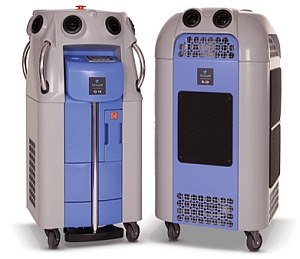Medical researchers from Johns Hopkins University in Baltimore and two other institutions found a commercial remote-controlled spraying device can reduce the rate of infections to some multidrug-resistant organisms found in hospitals. The team led by Johns Hopkins epidemiologist Trish Perl published its findings in the 1 January 2013 issue of the journal Clinical Infectious Diseases (paid subscription required).
The research team, which included colleagues Carolinas Medical Center in Charlotte and University of Massachusetts in Amherst, tested a bio-decontamination system made by Bioquell, a British medical and defense technologies company with offices in Horsham, Pennsylvania. Bioquell’s system (pictured left) is a self-contained remote-controlled device — 22 by 49 by 26 inches — that disinfects an entire empty patient’s room with a spray containing a hydrogen peroxide solution, leaving a fine vapor on all exposed surfaces, walls, and floor.
After spraying the hydrogen peroxide vapor, the system converts the spray to oxygen and water vapor, to make sure the room is safe to enter, without a separate “wipe-down” step. The robotic units are computer controlled and provide feedback on their progress to the system operators. Bioquell provided the systems used in the study.
Perl and colleagues tested the Bioquell system over a 30-month period in 1,300 patient rooms from three sections of Johns Hopkins medical center. The researchers collected samples on rooms occupied by 6,350 admissions to the hospital, comparing rates of multidrug-resistant organism infections to rooms serviced by the hydrogen-peroxide vapor systems to standard cleaning procedures. The comparisons of hydrogen-peroxide vapor treatments versus traditional methods were also compared to environmental samples collected for a 12-month period preceding the tests.
Overall, the researchers found multidrug-resistant organisms from prior-room occupants of the rooms in 22 percent of the admissions. The findings indicate the percentage of rooms contaminated with multidrug-resistant organisms was reduced significantly in the sections of the hospital treated with the hydrogen-peroxide vapor systems. In these hydrogen-peroxide vapor treated rooms, patients were 64 percent less likely to become contaminated with a multidrug-resistant organism.
The team found the rate of vancomycin-resistant enterococci infections — that can affect the urinary tract, bloodstream, or wounds associated with catheters or surgical procedures — reduced by 80 percent in hydrogen-peroxide vapor treated rooms. The results showed smaller reductions in infections from other hospital-related pathogens, such as Clostridium difficile and methicillin-resistant Staphylococcus aureus (MRSA).
A study by the Centers for Disease Control and Prevention in 2009 says health care associated infections occur in 4.5 of every 100 hospital admissions in the U.S. CDC estimated health care associated infections cost U.S. hospitals a total of $28 to $34 billion dollars annually.
Read more:
- UCLA to Study Copper Surfaces to Reduce Hospital Infections
- Daily Bathing of Elderly Sharply Reduces MRSA Infections
- Superbug Genetic Code Cracked, Resistance Factor Identified
- Tracking Antibiotic Use Reaps Big Hospital Cost Savings
* * *


 RSS - Posts
RSS - Posts
[…] Robotic Device Reduces Drug-Resistant Hospital Infections […]
[…] Robotic Device Reduces Drug-Resistant Hospital Infections […]
[…] Robotic Device Reduces Drug-Resistant Hospital Infections […]